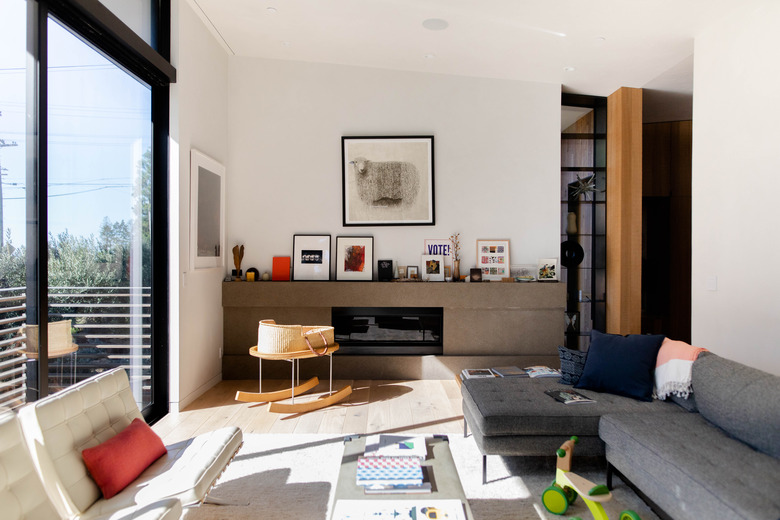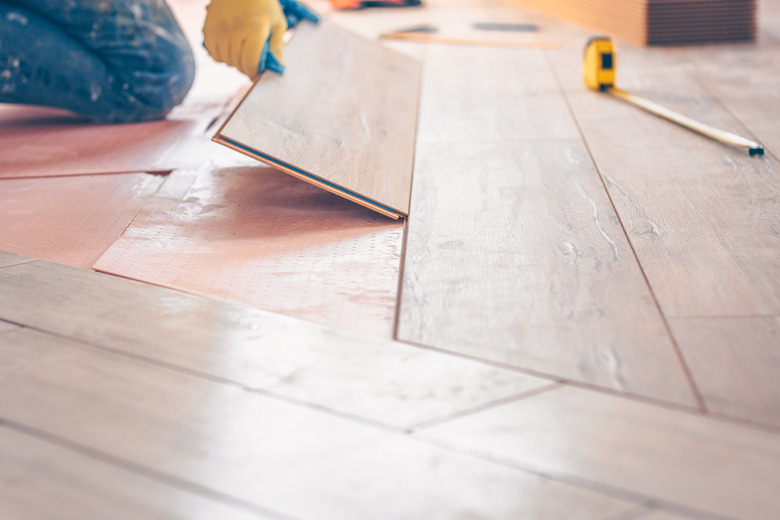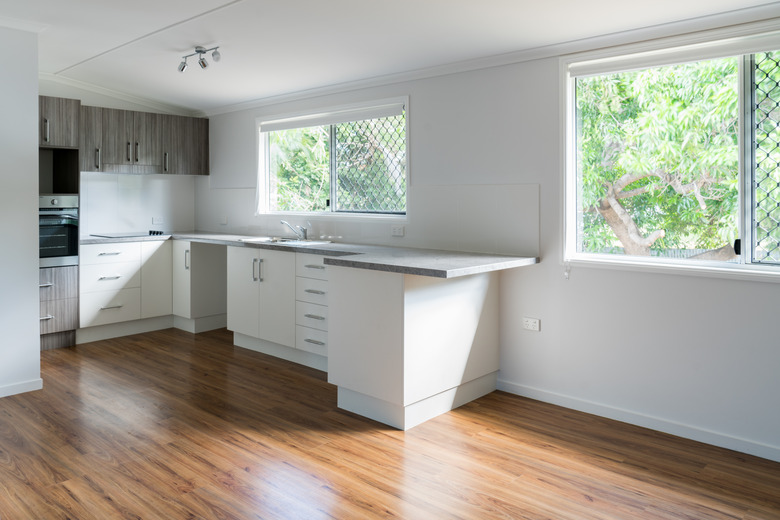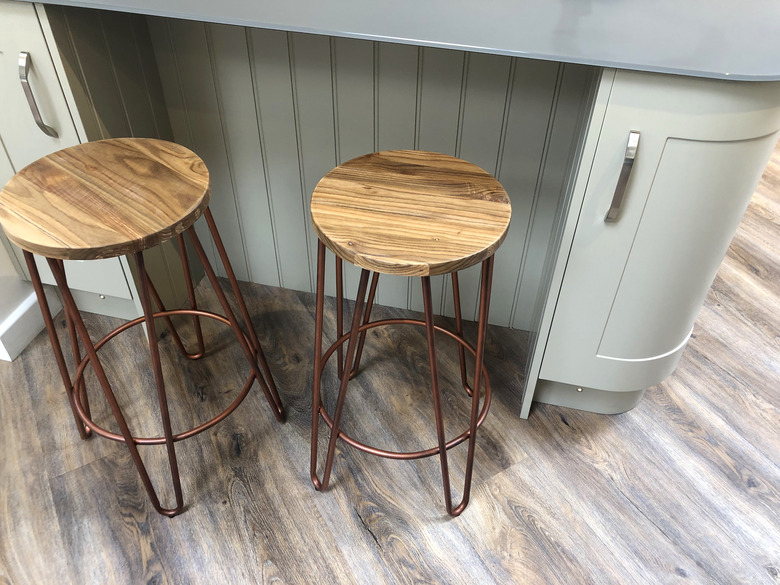A Homeowner's Guide To Luxury Vinyl Flooring (LVF)
Some people have a low opinion of vinyl flooring, perhaps picturing in their mind's eye the old floor in their grandmother's kitchen — but these people probably aren't acquainted with luxury vinyl flooring (LVF). Far from being a low-budget, utilitarian floor covering for kitchens and laundry rooms, luxury vinyl flooring is a quality option for the entire house that rivals hardwood and ceramic tile for aesthetic appeal and durability. It's less expensive than either option, and you can install it yourself so that you can save even more.
The term "luxury vinyl" usually refers to luxury vinyl plank flooring (LVP) and luxury vinyl tile flooring (LVT), and it also arguably includes vinyl sheet flooring, given that the quality of this utilitarian vinyl floor covering has improved in recent years. When it comes to sheet vinyl, you always have the option to save money by buying a budget product for as little as $1 per square foot that might help satisfy your nostalgia for your grandma's kitchen, but there's little chance of luxury vinyl flooring ever reminding you of days gone by.
The Difference a Core Makes
The Difference a Core Makes
Together with linoleum and rubber, vinyl flooring is an example of resilient flooring, so called because it is flexible. The first vinyl flooring appeared on the scene just after Waldo Sermon accidentally invented polyvinyl chloride in 1926. The first vinyl floor coverings were sheet vinyl and vinyl tiles, and they were often combined with other materials, including asbestos, to give them more body and durability.
In the latter part of the 20th century, someone got the idea to manufacture vinyl planks that resemble wood and that you glue to the subfloor. These are the precursors to luxury vinyl planks and luxury vinyl tiles, but there are a number of differences between them and more contemporary products.
- Modern LVT and LVP have more realistic and attractive patterns, and the flooring's wear layer is thicker and more durable.
- LVT and LVP come in floating-floor formats, making them easy to install. Because you don't have to glue down luxury vinyl flooring, you can install it over many existing floor coverings as well as on a bare subfloor.
- As opposed to early vinyl planks and tiles, LVT and LVP have a thick core that provides cushioning to make the floor more comfortable for walking and usually increases water resistance.
The core is probably the biggest difference between luxury vinyl products and traditional vinyl flooring. The gold standard in luxury vinyl flooring, wood plastic composite tiles and planks, have a rigid core that is 100 percent waterproof, meaning you can install this type of flooring anywhere. Luxury vinyl plank with a realistic wood pattern is a great alternative to wood flooring in moist locations where wood warps.
The Cost of Luxury Vinyl Flooring
The Cost of Luxury Vinyl Flooring
Unlike vinyl sheet flooring, luxury vinyl flooring isn't exactly cheap. While you might spend anywhere from $1 to $2 per square foot for sheet vinyl, the cost of luxury plank and luxury vinyl tile is between $2 and $7 per square foot, according to Floor Critics. Considering that luxury vinyl flooring is easy to install yourself, however, and sheet flooring requires professional installation, the savings in installation costs can be an important equalizer.
Compared to hardwood flooring or ceramic tile flooring, which almost always requires professional installation, luxury vinyl flooring is definitely the less-expensive option. Hardwood flooring costs anywhere from $3 to $7 per square foot to purchase and an extra $3 to $5 per square foot for installation. If you don't want to install LVT or LVP yourself, you only have to pay $1 to $4 per square foot for installation. You also save money on underlayment, which isn't needed for LVF, and you don't have to buy any nails or glue.
Comparing LVT and LVP
Comparing LVT and LVP
As the names suggest, luxury vinyl tile is usually square, and the pattern it displays resembles natural stone or ceramic tile. Luxury vinyl plank, on the other hand, comes in longer planks about the same size as laminate flooring planks, and it displays a wood pattern. That's basically the difference between these two examples of luxury vinyl flooring — one offers the appearance of stone or tile flooring, while the other gives your floor a wood look.
Both planks and tiles come in two different formats. One has a profile similar to that on laminate planks, with a locking mechanism that allows you to snap the planks or tiles together like puzzle pieces. The other format is a peel-and-stick strip on one side that holds the adjacent plank securely to make a floating floor that you don't have to glue down.
Pros and Cons of Luxury Vinyl Flooring
Pros and Cons of Luxury Vinyl Flooring
By choosing LVT or LVF, you're opting for an attractive floor at a cost that is about half that of installing hardwood or ceramic tile, and in some cases, it will last longer than more expensive flooring materials. It's flexible, so it won't crack on a less-than-perfect subfloor, as ceramic tile will, and it's water-resistant or waterproof depending on the brand, so it won't warp or separate like wood flooring planks.
A list of reasons you might want to choose luxury vinyl flooring would include the following benefits:
- It's cost-effective
- It's a DIY-friendly material to install
- It works almost anywhere
- It's attractive
Despite its pluses, LVF isn't for everyone, and it does have some drawbacks:
- It feels like a synthetic material, and on close inspection, it looks like one.
- It gets dented by heavy furniture resting on it for extended periods.
- It could contain phthalates or other chemicals that can affect sensitive people.
By itself, vinyl is a highly recyclable material, but in combination with the other materials used to manufacture LVF, much of it ends up in landfills where it doesn't biodegrade. If you're concerned about the environment, you might figure this into the equation when considering luxury vinyl flooring for your home.
Installing LVT and LVP Flooring
Installing LVT and LVP Flooring
Luxury vinyl is one of the easiest-to-install flooring options on the market. If you've ever installed laminate flooring, you'll know exactly how to install click-lock luxury vinyl flooring, and even if you don't have any flooring experience, you'll quickly get the hang of it. Because vinyl is a flexible and waterproof material, there are fewer subfloor requirements than there are for laminate flooring, and you don't need an underlayment.
Of the two available formats, the click-lock format is more common. You join planks or tiles by fitting the locking mechanisms together and pushing. It's actually a little more difficult to do than it sounds because vinyl is so bendable, but you seldom need tools other than a utility knife and ruler for cutting the planks or tiles to fit at the edges of the room.
The glue-together format is even easier, such as that employed on TrafficMaster vinyl planks that are designed for high-traffic areas. Each plank has a sticky strip affixed to one side and one end, and when you set the plank in its place on the floor and remove the protective paper from the strip, the plank is ready to be joined to another one. Set the next plank on the strip so that it's butted closely to the first one, push down to engage the adhesive and you're done.
Taking Care of Luxury Vinyl Flooring
Taking Care of Luxury Vinyl Flooring
As you might expect, LVT and LVP flooring requires very little maintenance other than vacuuming occasionally to keep the floor free of dirt and mopping or washing periodically with a cleaning solution. Water doesn't hurt vinyl the way it does hardwood and laminate flooring, so you can even use a steam mop. Quality vinyl flooring has a wear layer of UV-cured urethane that resists scuffs and bruises, and when they do occur, they are usually easy to remove.
The only precaution you need to remember is to avoid using wax or oil soap. Rather than making vinyl flooring shine, wax and oil add a layer of dirt and a gummy residue that detracts from the appearance of the floor rather than adding to it. If you want to enhance the shine of the floor, use a commercial product designed for cleaning vinyl.
Vinyl does fade, so any part of the floor exposed to direct sunlight may become lighter in color than the rest of the floor. To avoid this, place carpets on any part of the floor directly under a window, or even better, keep the curtains closed during the day when the sunlight is the most intense. Rearrange furniture periodically to avoid making dents and having it leave shadows on the floor.



